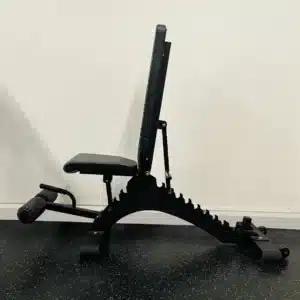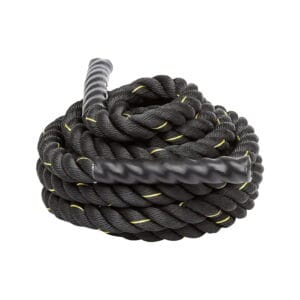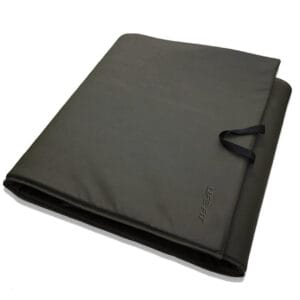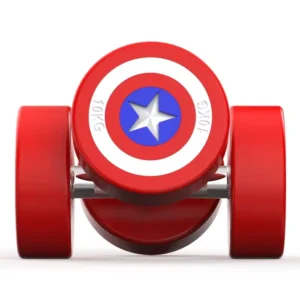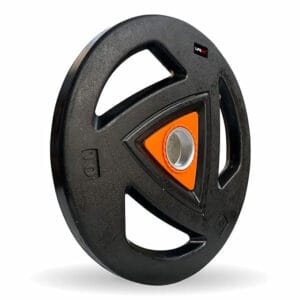
Home » Blog » Exercises » Ab Exercises » Barbell Ab Rollout Guide: Form, Benefits, and The Science of a Rock-Solid Core
Barbell Ab Rollout Guide: Form, Benefits, and The Science of a Rock-Solid Core
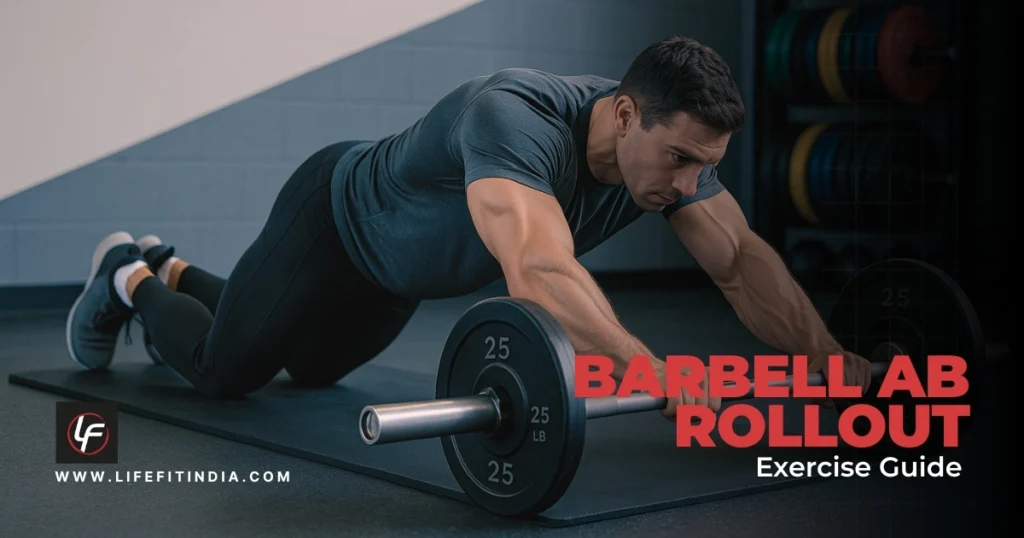
Still chasing a strong core with endless crunches? It’s time for a change. For serious results, master the barbell ab rollout—one of the most potent exercises for building a functional, chiseled midsection.
This isn’t just another exercise; it’s a masterclass in core stability that teaches your body to resist force and transfer power. But this power demands perfect technique.
The very thing that makes the rollout so effective also makes it risky if done wrong. That’s where this guide comes in.
We’ll break down the rollout from the ground up, moving beyond simple instructions to explore the science behind the movement. You will learn not just how to perform it, but why it works so well.
We’ll show you how to avoid common mistakes, prevent back pain, and progress safely from beginner to expert. This is an essential exercise for any strength training at home or gym routine.
Why the Barbell Ab Rollout is More Than Just a “Six-Pack” Exercise
While a visible ‘six-pack’ is a common goal, it’s a byproduct of what your core is truly designed for. Contrary to the spinal flexion trained by sit-up exercises, your core’s most critical function is to resist movement.
It acts as a rigid pillar, protecting your spine and transferring power from your legs to your arms. According to the experts at the Mayo Clinic, a strong core is essential for balance and stability.
This is why the barbell rollout is king. It’s an anti-extension exercise. As you roll the barbell away from your body, gravity tries to force your lumbar spine into a dangerous, arched position.
Your abdominal muscles have to contract with immense force isometrically (without changing length) to fight that extension and keep your spine safe. This skill has a direct carryover to keeping your back safe during heavy squats, deadlifts, and overhead presses, making you a stronger and more resilient athlete.
The Science of Anti-Extension: How the Barbell Ab Rollout Really Works
To truly appreciate the rollout, we need to look under the hood at the biomechanics and the data from scientific research.
Understanding the Lever Arm and Torque
The magic of the rollout lies in a simple physics principle: the lever arm. Think of your body as a lever, with your knees (or feet, in the advanced version) as the pivot point.
As you roll the barbell forward, the distance between the weight (your torso) and the pivot point increases. This lengthening of the lever arm dramatically increases the rotational force, or torque, that your core musculature must resist.
This is why the exercise feels exponentially harder the further you extend. It’s not just your body weight you’re fighting; it’s your body weight amplified by the power of leverage.
What the EMG Studies Reveal: A Look Inside Your Muscles
We don’t have to guess about the rollout’s effectiveness. Electromyography (EMG) studies, which measure the electrical activity in muscles, give us concrete proof.
Unmatched Rectus Abdominis Activation
The rollout is in a league of its own for activating the rectus abdominis. This is your main “six-pack” muscle.
A landmark 2010 study in the Journal of Orthopaedic & Sports Physical Therapy offers proof. It found rollouts create “very high” upper ab activation (63% of maximum). Lower ab activation was also “high” at 53%.
Crucially, the exercise uses the hip flexors very little. This avoids a common issue with sit-ups that can cause lower back discomfort.
The Critical Role of Obliques, Lats, and Pecs
The rollout is a full-body movement in disguise. The same EMG research shows high oblique activation (46% each).
These muscles are crucial for resisting rotation and maintaining stability. Furthermore, a 2015 study in Medical Express shows that as you extend, other muscles engage.
The Pectoralis Major (chest) and Latissimus Dorsi (lats) fire up. They help stabilize the shoulder and control the movement. The lats are the primary muscles you’ll use to initiate the pull back to the starting position.
How to Perform the Barbell Ab Rollout with Perfect Form (Video Guide)
Equipment Setup
All you need is a standard Olympic barbell and a pair of round bumper plates. Using 10kg (25lb) or 20kg (45lb) plates is ideal, as their large diameter provides a stable base for rolling.
For comfort, place a folded mat or a high-quality yoga mat under your knees.
The 5 Steps to a Perfect Rep
Follow these steps precisely. Each one is critical for safety and effectiveness.
1. The Setup: Posterior Pelvic Tilt is Non-Negotiable
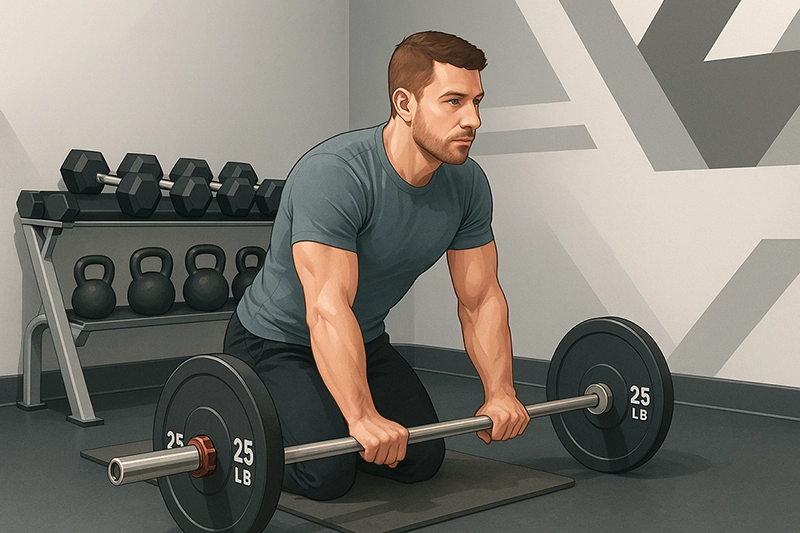
Kneel on the mat, gripping the barbell slightly wider than your shoulders. Before you even think about rolling, set your foundation: brace your core hard, as if preparing for an impact.
Then, perform a posterior pelvic tilt—tuck your tailbone underneath you and squeeze your glutes tightly. This action should flatten your lower back, removing any arch.
Hold this position; it’s the most critical step for protecting your spine.
2. The Rollout: Controlled Eccentric Extension
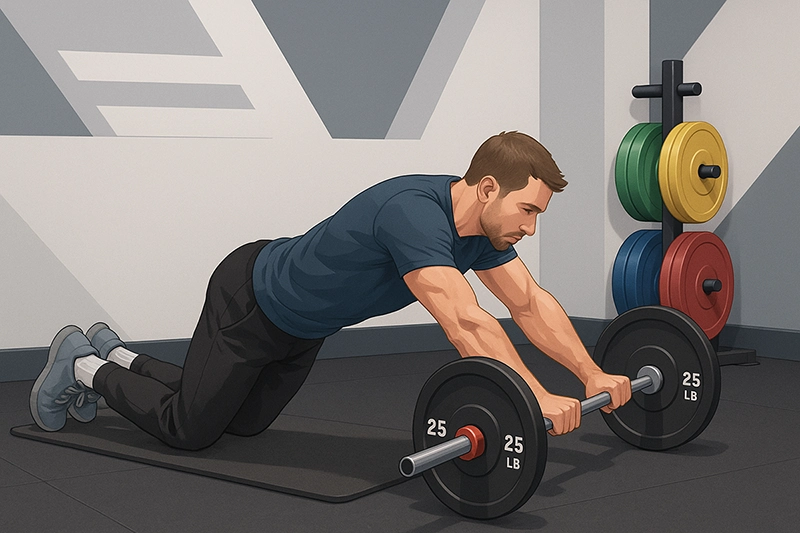
Initiate the movement by slowly rolling the barbell forward. Your hips and shoulders should move together as a single, solid unit.
Keep your arms straight and your core and glutes braced the entire time. Inhale as you roll out.
3. The Pause: Peak Tension at Full Extension
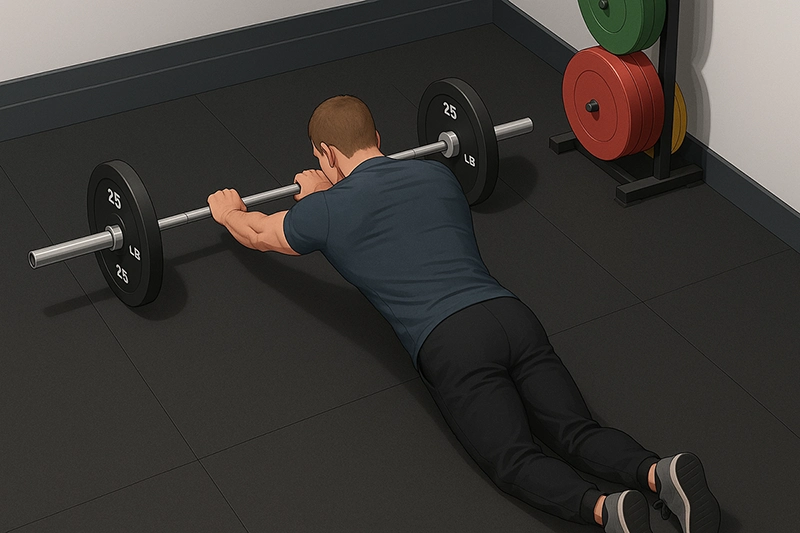
Roll out only as far as you can while maintaining a perfectly flat back. For most people, this will be when your arms are extended overhead and your chest is close to the floor.
Hold this position of peak tension for one full second. This is where the magic happens.
4. The Return: Initiating with the Lats and Abs
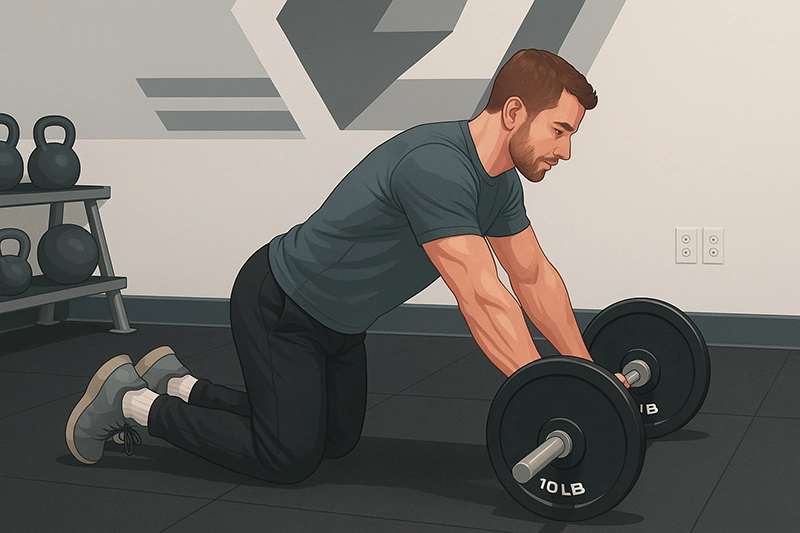
To begin the return journey, don’t just pull with your arms. Actively engage your lats by thinking about pulling the bar down and back towards your knees.
Squeeze your abs hard to help pull your torso back to the starting position. Exhale forcefully as you return.
5. The Reset: Maintaining Tension Between Reps
Return to the starting position but do not rest. Keep your abs and glutes engaged, ready for the next rep.
Do not allow your back to sag at any point.
The 5 Most Common Barbell Ab Rollout Mistakes (And How to Fix Them)
This section is crucial. Performing the rollout with poor form is a fast track to injury.
Arching the Lower Back (The #1 Injury Risk)
- The Mistake: As you roll out, your hips sag, and your lower back hyperextends into a deep arch. This transfers all the stress from your abs directly to your lumbar spine.
- The Fix: The fix is all about tension and honesty. Before you move, establish a strong posterior pelvic tilt and squeeze your glutes hard. This is your protection. Now, only roll out as far as you can honestly maintain that flat-back position. The moment you feel your back start to sag, you’ve found your current limit. Stop there and return. Don’t chase range of motion at the expense of your spine.[Placeholder for side-by-side image: Arched Back (Wrong) vs. Flat Back (Right)]
Dropping the Hips First
- The Mistake: You leave your hips behind as you roll out, essentially just pushing your arms forward.
- The Fix: Think of your body from your knees to your head as a solid plank of wood. Your hips and shoulders must move forward and back at the same time.
Bending the Elbows
- The Mistake: You bend your elbows on the way back, turning the exercise into a strange triceps extension.
- The Fix: Keep your arms locked straight throughout the entire movement. They are simply levers; your core and lats should be doing the work.
Using Momentum
- The Mistake: You perform the reps quickly, bouncing out of the bottom position.
- The Fix: Slow down. Use a deliberate tempo, such as 3 seconds out, 1-second pause, and 2 seconds back. This maximizes time under tension and ensures your muscles, not momentum, are in control.
Neglecting the Lats on the Return
- The Mistake: You struggle to get back to the start, trying to pull only with your arms and abs.
- The Fix: Before you initiate the return, actively think about pulling your shoulder blades down and back. This engages the powerful lat muscles and makes the return journey much stronger and smoother.
Your 4-Level Progression Plan: From Absolute Beginner to Rollout Master
The rollout is an advanced exercise. It’s vital to earn the right to perform it. Follow this progression plan and only move to the next level when you have mastered the current one.
1. Building the Foundation (Plank & Hollow Body Holds)
- Goal: Develop baseline isometric core strength.
- How: Master the standard forearm plank and the hollow body hold.
- Benchmark: You are ready to move on when you can hold a perfect plank for 60 seconds and a perfect hollow body hold for 30 seconds.
2. Introducing the Movement (Stability Ball Rollouts)
- Goal: Learn the rollout movement pattern with less resistance.
- How: Kneel in front of a stability ball with your hands on top. Perform the rollout motion just as you would with a barbell. The instability of the ball provides a unique challenge, but the load is much lower.
- Benchmark: You are ready to move on when you can complete 3 sets of 15 reps with perfect form.
3. The Main Event (Kneeling Barbell Rollouts)
- Goal: Master the standard barbell rollout.
- How: Start with a very limited range of motion, perhaps only rolling out a foot or two. As you get stronger, gradually increase the distance week by week, always prioritizing a flat back over range of motion.
- Benchmark: You are ready to move on when you can complete 3 sets of 10-12 full-range-of-motion reps.
4. The Ultimate Challenge (Standing Barbell Rollouts)
- Goal: Perform the pinnacle of core strength exercises.
- How: This is an incredibly advanced variation. Start from your feet with the barbell close to you. Hinge at the hips and roll out slowly. Most people will need to start by rolling out only part of the way or rolling towards a wall to stop their momentum.
- Benchmark: Completing a single, unassisted standing rollout is a huge feat of strength.
Muscles Worked in the Barbell Ab Rollout: A Deep Dive
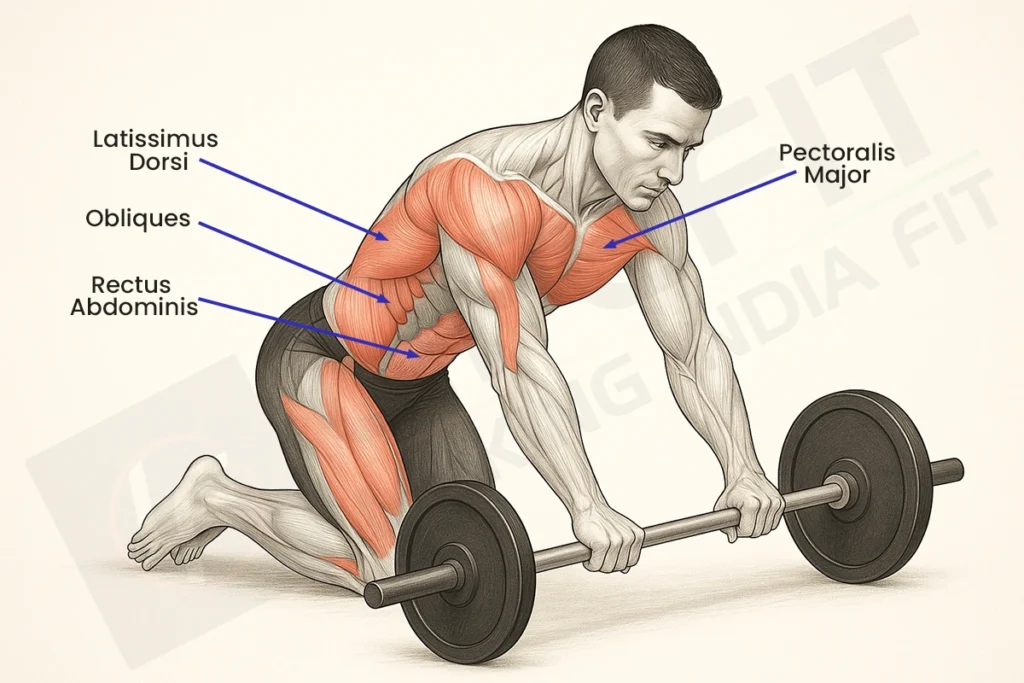
- Primary Movers: Rectus Abdominis & Obliques
- These are the stars of the show, working overtime to prevent spinal extension and stabilize the torso.
- Key Synergists: Latissimus Dorsi & Pectoralis Major
- The lats and pecs are critical for stabilizing the shoulder joint and, most importantly, for pulling you back to the starting position. Exercises like the dumbbell pullover can help strengthen this connection.
- Essential Stabilizers: Erector Spinae, Glutes, Serratus Anterior
- The erector spinae (lower back muscles) work isometrically to help keep the spine neutral. The glutes are squeezed to maintain the posterior pelvic tilt. The serratus anterior (the “boxer’s muscle” on your ribs) helps stabilize your shoulder blades.
Barbell Rollout vs. Ab Wheel vs. Crunches: Which is Best?
- Barbell vs. Ab Wheel: These are very similar. The barbell’s wider base makes it more stable and a better choice for beginners. The ab wheel’s narrower base is less stable, requiring more work from your obliques to prevent tipping.
- Rollouts vs. Crunches: There is no comparison. Crunches train spinal flexion, which has little carryover to athletic performance and can put repetitive stress on your spinal discs. Rollouts train anti-extension, the core’s true function, building a stable and resilient midsection. As the EMG data shows, rollouts also activate the abdominal musculature far more effectively than traditional weighted crunches.
Advanced Programming: Integrating Rollouts for Maximum Gains
- How Many Sets and Reps Should You Do?
- Because the rollout is so demanding, it’s best to keep the reps in the 8-15 range. Aim for 3-4 quality sets at the end of your workout.
- Advanced Variations: Landmine Rollouts & Weighted Rollouts
- Landmine Rollouts: Placing one end of a barbell in a landmine unit allows you to perform rollouts in an arc, which heavily challenges the obliques.
- Weighted Rollouts: Once you’ve mastered the standard version, you can wear a weighted vest to increase the challenge.
- Sample Workout Integration for Strength Athletes
- Place rollouts at the end of your squat or deadlift day. The anti-extension strength you build will have a direct carryover to your ability to stay braced and tight under a heavy bar in your squat rack.
Is the Barbell Rollout Dangerous? Addressing the Controversy
You may have heard that rollouts are “bad for your back.” Let’s be clear: the barbell rollout is not inherently dangerous, but performing it with poor form is.
The risk comes entirely from allowing your lumbar spine to hyperextend. As world-renowned spinal biomechanist Dr. Stuart McGill explains in his work, when your abs fatigue and you lose the posterior pelvic tilt, the load shifts from your muscles to the passive structures of your spine, creating dangerous shear forces. You can explore his foundational research on core stability and injury prevention at Backfitpro.
The exercise is not the problem; ego is. By following the progression plan, prioritizing perfect form over range of motion, and stopping your set the moment your form breaks down, you can completely mitigate the risks and reap all the rewards.
Frequently Asked Questions (FAQ)
Why does my back hurt when I do barbell ab rollouts?
This is the most common issue and a clear sign your lower back is arching during the movement. It means the load is shifting from your abs to your spine. The immediate fix is to reduce your range of motion significantly. Focus only on mastering the initial setup—the hard core brace and posterior pelvic tilt—within a shorter, pain-free range. Quality over quantity is key here.
Can I do rollouts every day?
No. Your abs are a muscle group like any other. They need time to recover and grow. The National Strength and Conditioning Association (NSCA) recommends at least 48 hours of rest for a muscle group after intense training. Training them 2-3 times per week is plenty.
What if I don't have a barbell?
You can use a dedicated ab wheel, a stability ball (as in the progression), or even a pair of dumbbells with round plates. The principle remains the same.
Conclusion: Rollout to a Stronger Core
You now have the blueprint to master the barbell ab rollout. This is more than an exercise; the movement is a skill that builds true core stability. A strong core protects your spine and boosts strength in all your lifts.
Remember to leave your ego at the door. Start at the right progression level. Focus on perfect, controlled reps, and listen to your body. Prioritizing form over range of motion builds a rock-solid, resilient core. This new strength will serve you both in and out of the gym.
Ready to build your ultimate workout space? The rollout is a fantastic start. Explore our complete collection of strength machines. Also, check out our barbells & plates. Equip your gym to reach your fitness goals.
About The Author
Arpan Singh
Best Equipment for Ab Exercise
-
 Multi Adjustable Gym Bench | Bench Press for Home Gym Rated 4.75 out of 5
Multi Adjustable Gym Bench | Bench Press for Home Gym Rated 4.75 out of 5₹34,999Original price was: ₹34,999.₹18,499Current price is: ₹18,499. Inc. 18% GST -
 Battle Rope for Full-Body Workout - 30ft Strength Training Rated 5.00 out of 5
Battle Rope for Full-Body Workout - 30ft Strength Training Rated 5.00 out of 5₹6,150Original price was: ₹6,150.₹5,400Current price is: ₹5,400. Inc. 18% GST -
 PVC Leatherette Yoga Mat: Unbeatable Non-Slip Raxine Rated 4.50 out of 5
PVC Leatherette Yoga Mat: Unbeatable Non-Slip Raxine Rated 4.50 out of 5₹2,999Original price was: ₹2,999.₹1,199Current price is: ₹1,199. Inc. 18% GST -
 Captain America Rubber Bouncer Dumbbells Rated 5.00 out of 5₹999 – ₹13,299Price range: ₹999 through ₹13,299 Inc. 18% GST
Captain America Rubber Bouncer Dumbbells Rated 5.00 out of 5₹999 – ₹13,299Price range: ₹999 through ₹13,299 Inc. 18% GST -
 Triangle Olympic Weight Plates Diameter -50mm Rated 5.00 out of 5₹1,949 – ₹19,999Price range: ₹1,949 through ₹19,999 Inc. 18% GST
Triangle Olympic Weight Plates Diameter -50mm Rated 5.00 out of 5₹1,949 – ₹19,999Price range: ₹1,949 through ₹19,999 Inc. 18% GST -
 LIFE FIT Pro Series Functional Trainer Machine
LIFE FIT Pro Series Functional Trainer Machine
₹135,700Original price was: ₹135,700.₹95,000Current price is: ₹95,000. Inc. 18% GST
